Zack Xuereb Conti
Geometric Principles for Machine Learning of Dynamical Systems
Feb 19, 2025Abstract:Mathematical descriptions of dynamical systems are deeply rooted in topological spaces defined by non-Euclidean geometry. This paper proposes leveraging structure-rich geometric spaces for machine learning to achieve structural generalization when modeling physical systems from data, in contrast to embedding physics bias within model-free architectures. We consider model generalization to be a function of symmetry, invariance and uniqueness, defined as a topological mapping from state space dynamics to the parameter space. We illustrate this view through the machine learning of linear time-invariant dynamical systems, whose dynamics reside on the symmetric positive definite manifold.
Impact of data usage for forecasting on performance of model predictive control in buildings with smart energy storage
Feb 19, 2024Abstract:Data is required to develop forecasting models for use in Model Predictive Control (MPC) schemes in building energy systems. However, data usage incurs costs from both its collection and exploitation. Determining cost optimal data usage requires understanding of the forecast accuracy and resulting MPC operational performance it enables. This study investigates the performance of both simple and state-of-the-art machine learning prediction models for MPC in a multi-building energy system simulation using historic building energy data. The impact of data usage on forecast accuracy is quantified for the following data efficiency measures: reuse of prediction models, reduction of training data volumes, reduction of model data features, and online model training. A simple linear multi-layer perceptron model is shown to provide equivalent forecast accuracy to state-of-the-art models, with greater data efficiency and generalisability. The use of more than 2 years of training data for load prediction models provided no significant improvement in forecast accuracy. Forecast accuracy and data efficiency were improved simultaneously by using change-point analysis to screen training data. Reused models and those trained with 3 months of data had on average 10% higher error than baseline, indicating that deploying MPC systems without prior data collection may be economic.
Energy Modelling and Forecasting for an Underground Agricultural Farm using a Higher Order Dynamic Mode Decomposition Approach
Jun 26, 2023Abstract:This paper presents an approach based on higher order dynamic mode decomposition (HODMD) to model, analyse, and forecast energy behaviour in an urban agriculture farm situated in a retrofitted London underground tunnel, where observed measurements are influenced by noisy and occasionally transient conditions. HODMD is a data-driven reduced order modelling method typically used to analyse and predict highly noisy and complex flows in fluid dynamics or any type of complex data from dynamical systems. HODMD is a recent extension of the classical dynamic mode decomposition method (DMD), customised to handle scenarios where the spectral complexity underlying the measurement data is higher than its spatial complexity, such as is the environmental behaviour of the farm. HODMD decomposes temporal data as a linear expansion of physically-meaningful DMD-modes in a semi-automatic approach, using a time-delay embedded approach. We apply HODMD to three seasonal scenarios using real data measured by sensors located at at the cross-sectional centre of the the underground farm. Through the study we revealed three physically-interpretable mode pairs that govern the environmental behaviour at the centre of the farm, consistently across environmental scenarios. Subsequently, we demonstrate how we can reconstruct the fundamental structure of the observed time-series using only these modes, and forecast for three days ahead, as one, compact and interpretable reduced-order model. We find HODMD to serve as a robust, semi-automatic modelling alternative for predictive modelling in Digital Twins.
A Physics-based Domain Adaptation framework for modelling and forecasting building energy systems
Aug 19, 2022



Abstract:State-of-the-art machine-learning based models are a popular choice for modelling and forecasting energy behaviour in buildings because given enough data, they are good at finding spatiotemporal patterns and structures even in scenarios where the complexity prohibits analytical descriptions. However, machine-learning based models for building energy forecasting have difficulty generalizing to out-of-sample scenarios that are not represented in the data because their architecture typically does not hold physical correspondence to mechanistic structures linked with governing phenomena of energy transfer. Thus, their ability to forecast for unseen initial conditions and boundary conditions wholly depends on the representativeness in the data, which is not guaranteed in building measurement data. Consequently, these limitations impede their application to real-world engineering applications such as energy management in Digital Twins. In response, we present a Domain Adaptation framework that aims to leverage well-known understanding of phenomenon governing energy behavior in buildings to forecast for out of sample scenarios beyond building measurement data. More specifically, we represent mechanistic knowledge of energy behavior using low-rank linear time-invariant state space models and subsequently leverage their governing structure to forecast for a target energy system for which only building measurement data is available. We achieve this by aligning the Physics-derived subspace that governs global state space behavior closer towards the target subspace derived from the measurement data. In this initial exploration we focus on linear energy systems; we test the subspace-based DA framework on a 1D heat conduction scenario by varying the thermophysical properties of the source and target systems to demonstrate the transferability of mechanistic models from Physics to measurement data.
 Add to Chrome
Add to Chrome Add to Firefox
Add to Firefox Add to Edge
Add to Edge